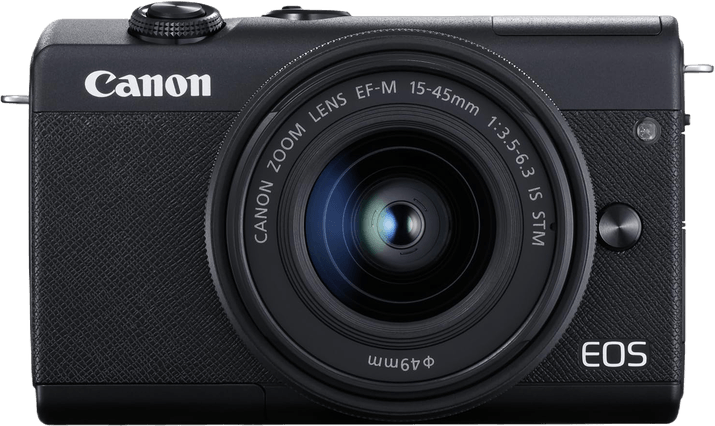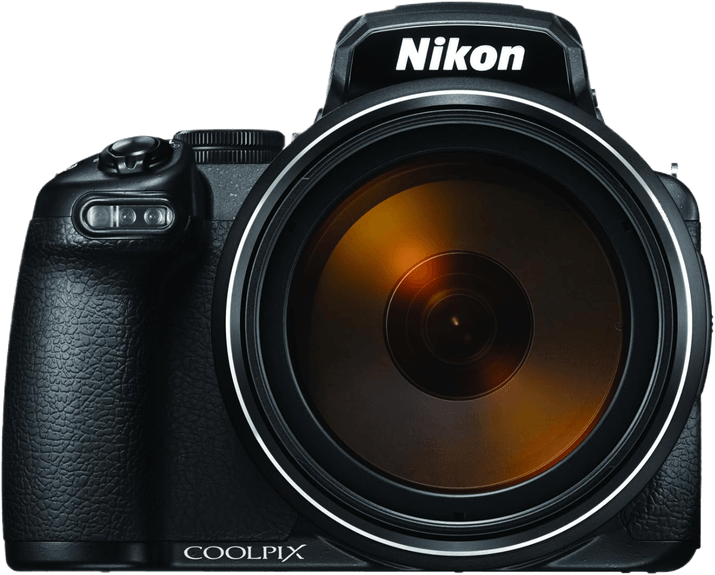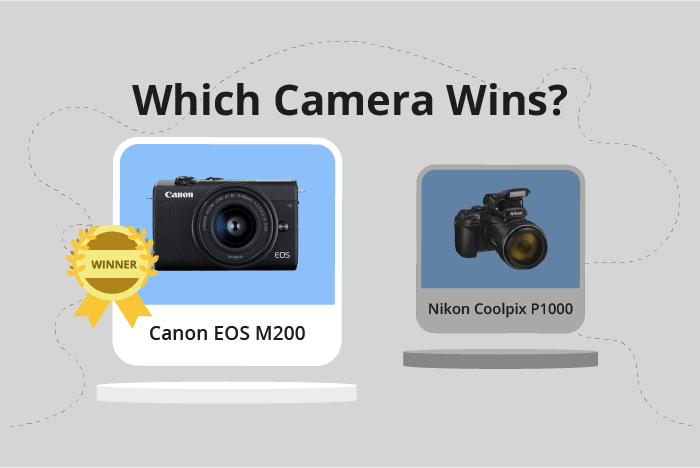Canon EOS M200 vs Nikon Coolpix P1000 Comparison
Canon EOS M200

Nikon Coolpix P1000

The Canon EOS M200 emerges as the winner with a score of 59/100, while the Nikon Coolpix P1000 trails behind at 52/100. Both cameras share the same release year, 2019, and are designed for different purposes – the M200 being a mirrorless camera and the P1000 being a bridge camera.
The EOS M200 stands out with its compact size (108 x 67 x 35mm) and lightweight body (229g), making it easier to carry and handle. Additionally, it has a more affordable launch price of $599 compared to the P1000’s $999.95.
On the other hand, the Nikon Coolpix P1000 offers a larger and more robust build (146 x 119 x 181mm) and weighs 1415g. This suggests that the P1000 is geared towards photographers who prioritize durability and stability.
Ultimately, the Canon EOS M200 is the better choice for those seeking a compact, lightweight, and budget-friendly option, while the Nikon Coolpix P1000 caters to photographers who value a sturdier camera.
Canon EOS M200 vs Nikon Coolpix P1000 Overview and Optics
The Canon EOS M200 comes out ahead in the optics comparison, scoring 58/100, while the Nikon Coolpix P1000 trails with a score of 53/100. Both cameras share some specs, including CMOS sensor types and processors, with the M200 using a Digic 8 processor and the P1000 utilizing an Expeed processor.
The winning camera, the Canon EOS M200, boasts a higher megapixel count of 24, compared to the P1000’s 16 megapixels. This results in sharper, higher-resolution images. Additionally, the M200 features a larger APS-C sensor size, which contributes to better image quality and low-light performance than the P1000’s smaller 1/2.3″ sensor. The M200 also offers a lens mount (Canon EF-M) for interchangeable lenses, providing versatility and adaptability for various shooting situations.
However, the Nikon Coolpix P1000 does have some advantages, such as a faster shooting speed of 7 frames per second compared to the M200’s 6.1 fps. This can be beneficial for capturing fast-moving subjects. The P1000 also has a higher DXOMARK score for its sensor (69) compared to the M200 (58), which means it potentially offers better overall image quality. Furthermore, the P1000 features image stabilization, which can help reduce camera shake and produce clearer images, while the M200 lacks this feature.
In the optics comparison, the Canon EOS M200 emerges as the better camera due to its higher megapixel count, larger sensor size, and lens mount for interchangeable lenses. However, the Nikon Coolpix P1000 has its advantages with a faster shooting speed, higher DXOMARK sensor score, and image stabilization. Each camera has its strengths, and the choice ultimately depends on the photographer’s needs and preferences.
Canon EOS M200 vs Nikon Coolpix P1000 Video Performance
The Canon EOS M200 and the Nikon Coolpix P1000 both have a video score of 83/100, making them equal in terms of video capabilities. They share common specifications, such as 4K max video resolution, 3840 x 2160 max video dimensions, 60fps max video frame rate, and built-in time-lapse functionality.
Despite having the same video score, the Canon EOS M200 has some advantages over the Nikon Coolpix P1000. However, these advantages are not specified in the given information. Therefore, it is not possible to state what makes the Canon EOS M200 better in terms of video capabilities.
On the other hand, the Nikon Coolpix P1000 also has some advantages over the Canon EOS M200. Yet, these advantages are not specified in the given information. Therefore, it is not possible to state what makes the Nikon Coolpix P1000 better in terms of video capabilities.
Based on the available information, both cameras have the same video score and share the same video specifications. This means that they are equal in terms of video capabilities. Users should consider other factors, such as price, design, and additional features, when choosing between these two cameras.
Canon EOS M200 vs Nikon Coolpix P1000 Features and Benefits
The Canon EOS M200 emerges as the winner in the features category, scoring 70/100 compared to the Nikon Coolpix P1000’s 57/100. Both cameras share some common specifications, such as a flip screen, Wi-Fi, and Bluetooth connectivity. They also lack GPS functionality.
The Canon EOS M200 outperforms the Nikon Coolpix P1000 in several aspects. Its screen resolution is higher at 1,040,000 dots, compared to the Nikon’s 921,600 dots. This difference results in a sharper display for the Canon EOS M200. Additionally, the Canon EOS M200 has a touchscreen, which makes it more user-friendly and convenient to operate.
The Nikon Coolpix P1000, however, has a slightly larger screen size of 3.2 inches, compared to the Canon EOS M200’s 3-inch screen. This larger screen provides a more comfortable viewing experience for the user. Despite this advantage, the Nikon Coolpix P1000’s lower feature score suggests that it falls short in other areas compared to the Canon EOS M200.
Taking these points into consideration, the Canon EOS M200 proves to be the better camera in terms of features. Its higher screen resolution and touchscreen functionality contribute to its superior score. The Nikon Coolpix P1000’s larger screen size does provide some benefit, but it does not outweigh the advantages offered by the Canon EOS M200.
Canon EOS M200 vs Nikon Coolpix P1000 Storage and Battery
The Nikon Coolpix P1000 wins in storage and battery, scoring 29 points, while the Canon EOS M200 scores 21 points. Both cameras have a single memory card slot and accept SD, SDHC, and SDXC (UHS-I compatible) memory cards.
The Nikon P1000 has a better battery advantage, offering USB charging, which is absent in the Canon M200. However, the Canon M200 has a longer battery life, providing 315 shots compared to the Nikon P1000’s 250 shots. The battery types differ, with the Canon using an LP-E12 battery and the Nikon utilizing an EN-EL20a battery.
Despite its lower score, the Canon M200 offers a longer battery life, which can be beneficial for extended shooting sessions. On the other hand, the Nikon P1000’s USB charging capability makes it more versatile and convenient for on-the-go charging. Both cameras have their merits, but the Nikon P1000’s higher score reflects its superior convenience in storage and battery management.
Canon EOS M200 vs Nikon Coolpix P1000 – Our Verdict
Are you still undecided about which camera is right for you? Have a look at these popular comparisons that feature the Canon EOS M200 or the Nikon Coolpix P1000:

